Understanding Autism Spectrum Disorder in Italy
Autism Spectrum Disorder (ASD) affects approximately 600,000 people in Italy, including around 100,000 children under the age of 18. As a lifelong condition, ASD presents significant challenges not only for individuals but also for their families and society. The impacts ripple across developmental, social, and economic dimensions, underscoring the critical importance of effective interventions, services, and support systems throughout the country.
Prevalence and Societal Impact of Autism in Italy
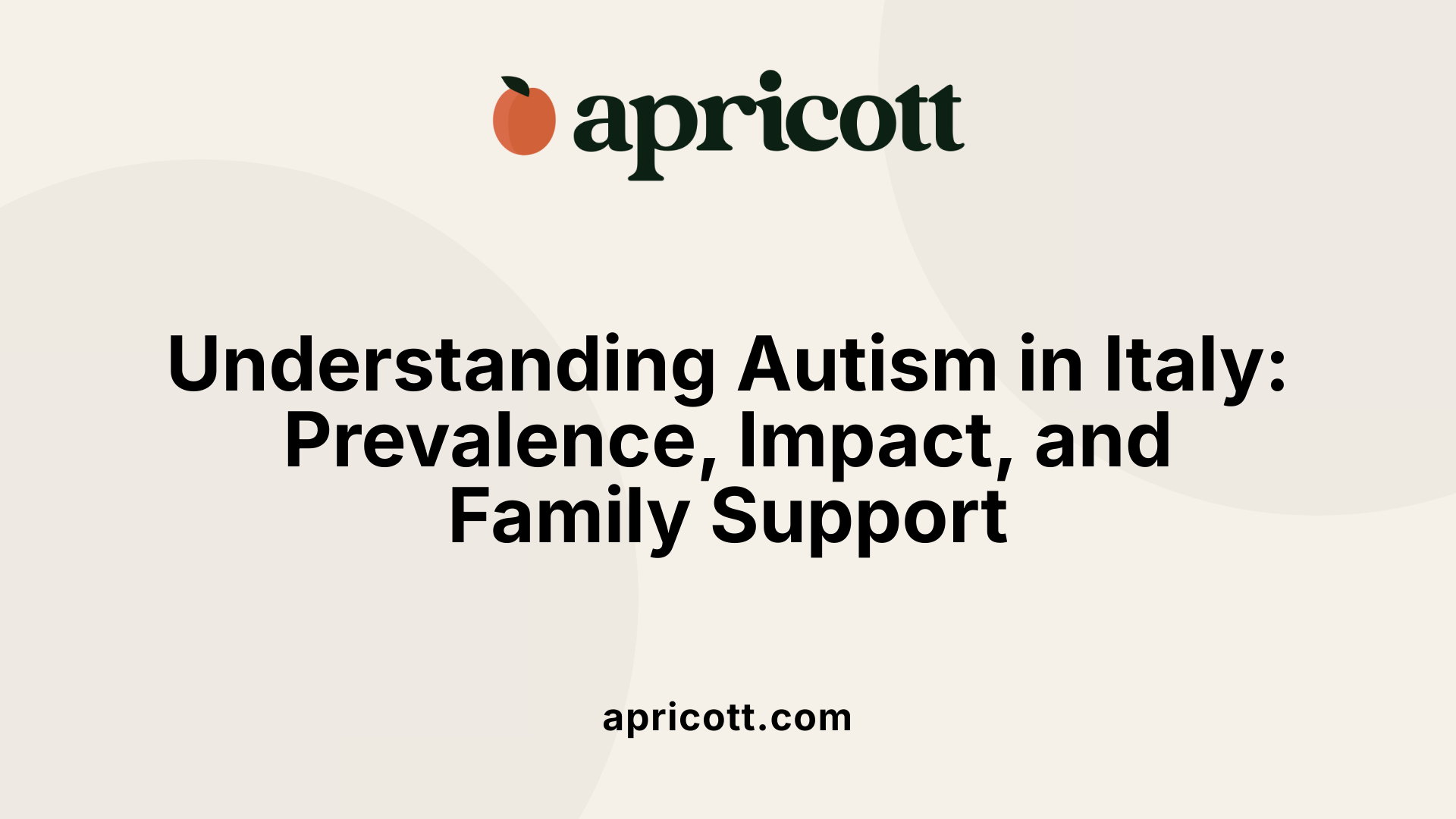
How prevalent is ASD in Italy?
There are approximately 600,000 individuals diagnosed with Autism Spectrum Disorder (ASD) across Italy. Of these, around 100,000 are children under the age of 18, which highlights the significant number of young people requiring specialized support.
Is ASD a lifelong condition?
ASD is considered a lifelong neurodevelopmental condition. This means that individuals diagnosed with ASD require ongoing support and interventions tailored to their evolving needs throughout their lives.
What are the societal and familial costs of ASD?
The impact of ASD extends beyond the individuals diagnosed, affecting families and society at large. The condition imposes considerable personal challenges, and societal costs include healthcare, education, and social services. Families often need to adjust their daily lives and resources to meet the demands of care and support.
How does ASD affect caregivers?
Caregivers of people with ASD frequently experience high levels of stress, anxiety, and depression. These psychological burdens stem from the challenges associated with caregiving duties, navigating complex health and educational systems, and coping with the lifelong aspect of the disorder.
This overview shows the importance of continued resources, professional support, and systemic coordination in Italy to address both the widespread prevalence and profound impact of ASD on individuals, families, and communities.
Italy’s Healthcare Framework for Autism: Strengths and Regional Disparities

What is the nature of ASD healthcare services in Italy?
Italy offers a comprehensive network of child and adolescent mental health services (CAMHs), fully integrated into the national health system. These services include local health units, hospitals, research institutions, and private providers. Their design ensures multidisciplinary care addressing the diverse needs of individuals with autism spectrum disorder (ASD).
Structure of child and adolescent mental health services (CAMHs) in Italy
CAMHs are the cornerstone for delivering ASD-related healthcare, offering diagnostic, intervention, and support services. Public CAMHs cover approximately 75% of ASD intervention needs, focusing on therapies, behavioral interventions, and family support. Conversely, private CAMHs tend to concentrate more on diagnostic services, complementing public offerings.
Integration into the national health system
The national health system supports CAMHs by promoting coordination among various healthcare providers, research entities, and educational institutions to foster evidence-based practices and continuity of care. This cohesive framework facilitates access to standardized diagnostic tools such as ADOS-G and CARS, although tool usage varies by region.
Geographical disparities in service availability and quality
Significant disparities exist across Italy’s macro-areas, with northern regions typically exhibiting superior resources, infrastructure, and staff expertise for ASD services. The southern and some central regions face challenges including reduced availability of intervention programs, fewer specialized professionals, and limited family support mechanisms.
Public vs. private CAMHs involvement
Public CAMHs predominantly provide extensive ASD interventions, including behavioral therapies like Applied Behavior Analysis (ABA), communication enhancement tools like Picture Exchange Communication System (PECS), speech therapy, and family-centered support. Private CAMHs primarily offer diagnostics, addressing the demand for assessments but often lacking the intervention scope found in public services.
This complex landscape underscores Italy’s efforts to address ASD care through an integrated health system, though regional inequalities suggest ongoing needs for national standards and better coordinated service delivery.
Diagnostic Practices and Tools Used Across Italian ASD Centers
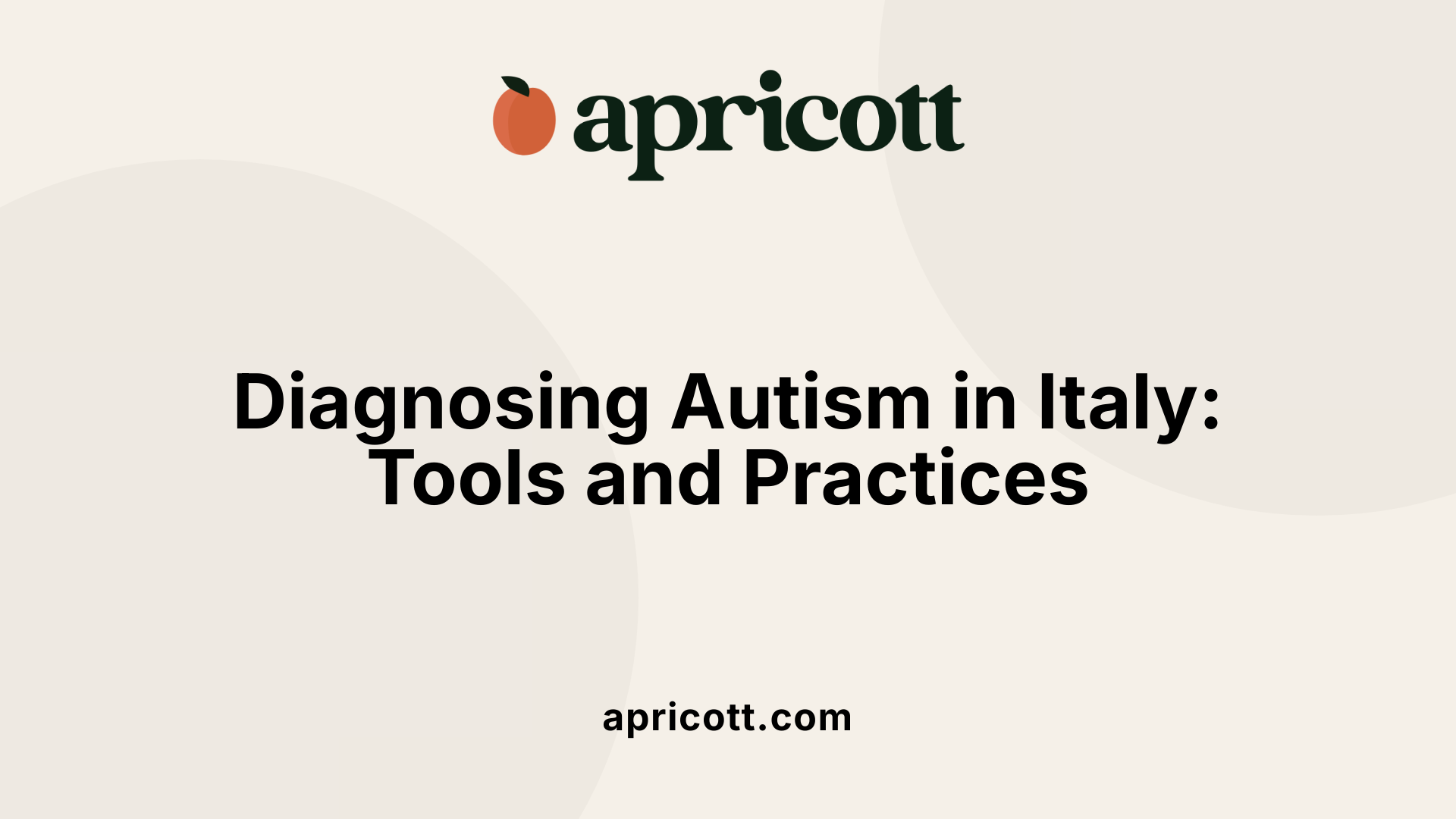
What diagnostic tools and systems are used for ASD in Italy?
Across Italy, the diagnosis of Autism Spectrum Disorder (ASD) heavily relies on standardized tools such as the Autism Diagnostic Observation Schedule-Generic (ADOS-G) and the Childhood Autism Rating Scale (CARS). These tools are designed to assess the presence and severity of autism-related behaviors, providing structured observations and ratings.
Most Italian centers employ the ICD-10 diagnostic system as their primary classification method. However, some regions have adopted the DSM-IV system, reflecting regional preferences or historical practice variations.
There are marked regional differences in the application of diagnostic protocols. While some areas follow formalized diagnostic procedures with clear steps, others lack standardized protocols, leading to inconsistency in assessment quality.
Assessment of comorbid conditions common in ASD, such as intellectual disabilities or behavioral disorders, is less uniformly practiced. Many centers do not consistently use specialized tools for these evaluations, which can affect comprehensive care planning.
These variations highlight the need for harmonized diagnostic guidelines and training to ensure consistent and thorough ASD diagnosis across Italy.
Training and Professional Development in Autism Services in Italy

How is professional training for ASD services structured in Italy?
In Italy, professional training for autism spectrum disorder (ASD) services is widely provided across child and adolescent mental health services (CAMHs). These training programs are designed to enhance the skills of clinical and educational staff who work directly with individuals with autism. Emphasis is placed on evidence-based approaches such as Applied Behavior Analysis (ABA) and communication methods like the Picture Exchange Communication System (PECS).
Availability of specialized training for ASD professionals
Most CAMHs offer autism-specific training programs aimed at equipping professionals with the latest knowledge and intervention strategies. This specialized education extends to multidisciplinary teams, including psychologists, educators, and healthcare managers, ensuring a comprehensive support network for individuals with ASD.
Regional disparities in training and funding
Despite this widespread availability, there are significant regional differences in the availability and quality of training. The northern regions of Italy show higher levels of autism-specific training and receive more financial support compared to central and southern regions. This uneven distribution affects the consistency and quality of care across the country.
Role of training in improving service quality
Training plays a crucial role in improving the overall quality of autism services in Italy. Well-trained professionals contribute to more effective interventions, better coordination among schools, families, and health services, and improved outcomes in communication, social skills, and behavior management for children with autism. Continuous professional development also supports the implementation of standardized protocols and encourages research collaboration, crucial for advancing knowledge and practice within the country.
Applied Behavior Analysis (ABA) Therapy: Scientific Foundation and Goals

What is Applied Behavior Analysis (ABA) therapy and how does it help individuals with autism?
Applied Behavior Analysis (ABA) is a therapeutic approach grounded in behavioral science. It uses systematic techniques based on the principles of behavior to promote learning and positive behaviors in individuals with autism.
In Italy, ABA is widely recognized for its efficacy. It involves designing individualized intervention plans that focus on specific targets, such as communication and social interaction. Through repeated practice and reinforcement, ABA helps children with autism acquire new skills and reduce behaviors that may be challenging. Professionals use data to monitor progress and adjust interventions accordingly, ensuring each person’s developmental needs are met.
What are the common goals of behavioral therapy for individuals with autism?
The overarching aims of ABA therapy center on enhancing a variety of skills essential for everyday life. These include:
- Communication Skills: Developing both expressive and receptive language abilities to improve how children communicate their needs and understand others.
- Social Interaction: Teaching social skills such as recognizing emotions, engaging with peers, and participating in group settings.
- Adaptive Behaviors: Improving self-care routines like toileting and hygiene that promote autonomy.
- Community Functioning: Building skills required to safely navigate public spaces and interact within the broader community.
This goal-oriented framework supports personal growth and greater independence, tailoring strategies to each child's unique profile.
ABA application and collaborative frameworks in Italy
Italian centers like Centro Tice implement ABA through multidisciplinary teams consisting of psychologists, educators, and managers trained in behavioral analysis. Their interventions occur in specialized settings, emphasizing collaboration among the student, family, and educational systems.
This integrated approach not only enhances skill acquisition but also supports generalization of learning across home, school, and community environments. The commitment to research, professional training, and scientific dissemination further reinforces the solid foundation ABA holds in Italy’s autism services.
| Aspect | Description | Italian Context Example |
|---|---|---|
| Scientific Basis | Behavioral principles and data-driven intervention | Recognized by the Italian Superior Institute of Health |
| Primary Therapeutic Goals | Communication, social, adaptive, and community skills | Includes speech development, social engagement, and independence for children with autism |
| Intervention Format | Individualized plans, repeated practice, reinforcement | Implemented by multidisciplinary teams, such as those at Centro Tice |
| Settings | Specialized centers, school, home (in some cases) | Naturalistic approach with interventions primarily in centers, involving families and schools |
| Outcome Monitoring | Continuous data collection and plan adjustment | Ongoing research and professional training to ensure evidence-based practice |
Recognition and Adoption of ABA in Italian Autism Care Guidelines
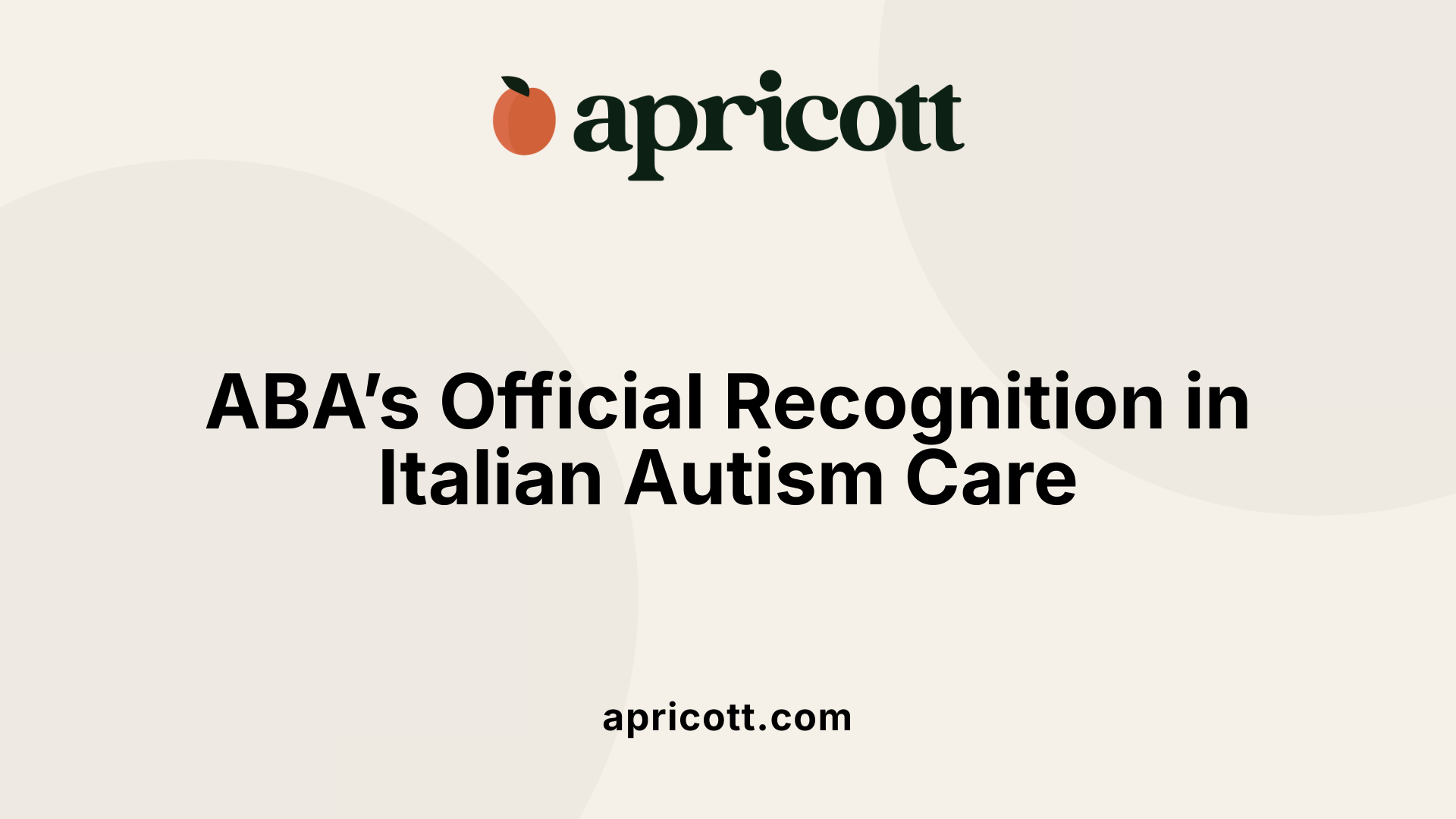
How is ABA therapy officially recognized in Italy?
The Italian Superior Institute of Health (ISS) formally acknowledged Applied Behavior Analysis (ABA) in its 2011 guidelines as an effective and evidence-based intervention for individuals with autism spectrum disorder (ASD). This endorsement underlines ABA's status as a primary recommended therapy within the country's autism care protocols.
The ISS guidelines endorsed ABA due to its systematic use of behavioral principles grounded in scientific research, demonstrating measurable improvements in developmental outcomes for people with ASD. This recognition has promoted wider adoption of ABA methodologies across therapeutic and educational settings within Italy.
As a result, ABA remains a cornerstone intervention supported by professional training programs and integrated clinical practices. It is utilized extensively in centers such as Centro Tice, which emphasize multidisciplinary, naturalistic ABA-based approaches, reflecting the therapy's acceptance in both research and practical application spheres throughout Italy.
Factors Influencing ABA Therapy Outcomes in Italy

What factors affect the effectiveness of ABA therapy in Italy?
Applied Behavior Analysis (ABA) therapy is widely acknowledged as an effective intervention for children with autism spectrum disorder (ASD) in Italy, but its success hinges on several influential factors.
Firstly, early intervention plays a crucial role. Initiating ABA therapy at a young age allows for greater developmental progress, capitalizing on the child's neuroplasticity during critical learning periods.
Secondly, the child's cognitive, linguistic, and educational skills significantly impact treatment outcomes. Children with stronger baseline abilities in these areas tend to respond more positively to ABA, facilitating smoother acquisition of communication and social skills.
Additionally, the intensity of the therapy—meaning the frequency and duration of sessions—is vital. More intensive ABA programs often yield more pronounced improvements in behavior and learning.
Finally, family involvement is fundamental for sustaining progress. Active participation by parents and caregivers helps generalize skills learned in therapy to daily life and supports continuity outside clinical settings.
Together, these factors create a framework where ABA therapy can maximize its benefits for children with ASD in Italy, ensuring tailored and effective interventions.
Professional Teams Delivering ABA Therapy in Italy: Qualifications and Roles

Who typically provides ABA therapy services, and what qualifications do these professionals have?
Applied Behavior Analysis (ABA) therapy in Italy is delivered by highly qualified professionals with specialized training. A central role is played by Board Certified Behavior Analysts (BCBAs), who possess advanced graduate degrees and have completed rigorous certification processes ensuring their expertise in ABA principles and interventions.
Supporting the BCBAs are Registered Behavior Technicians (RBTs), trained personnel who carry out day-to-day therapy sessions under the close supervision of BCBAs. These technicians are crucial for consistent implementation of treatment plans and for gathering data on the child’s progress.
Italian ABA teams are distinctly multidisciplinary. They often include psychologists and educators certified in ABA methodologies, creating a well-rounded approach to intervention. For instance, institutions like Centro Tice employ such diverse teams comprising managers, psychologists, and educators, all holding recognized qualifications in ABA. This composition ensures comprehensive care that addresses educational, psychological, and behavioral aspects collectively.
Importance of professional qualifications and certifications
Professional certifications and qualifications are vital in maintaining the quality and effectiveness of ABA therapy in Italy. Formal qualifications like those of BCBAs and RBTs guarantee adherence to evidence-based practices and ethical standards. They also ensure that interventions are individualized and scientifically informed, which is essential for accommodating the diverse needs of children with autism spectrum disorder (ASD).
In summary, ABA therapy services in Italy are provided by well-trained multidisciplinary teams. Their qualifications and collaboration underpin effective interventions tailored to support children with ASD, highlighting the significance of certified expertise in behavioral health services.
| Professional Role | Qualifications/Certifications | Role in ABA Therapy |
|---|---|---|
| Board Certified Behavior Analyst (BCBA) | Advanced graduate degrees; BCBA certification | Designs treatment plans; supervises RBTs |
| Registered Behavior Technician (RBT) | RBT certification; supervised practice | Delivers therapy; collects data |
| Psychologists | Degrees in psychology; ABA training | Provides behavioral assessment; collaborates treatment |
| Educators | Teaching background; ABA certification or training | Implements educational interventions; supports integration |
Centro Tice: A Model Institution for ABA-Based Autism Interventions in Italy

Use of ABA as the Foundational Approach at Centro Tice
Centro Tice bases its autism interventions primarily on Applied Behavior Analysis (ABA), acknowledging it as a systematic, evidence-based method derived from scientific research. This foundation ensures structured, effective treatment aligned with the national recognition of ABA’s efficacy by Italy’s Superior Institute of Health.
Naturalistic Interventions Conducted in Specialized Centers
Unlike some ABA programs that focus on in-home therapies, Centro Tice emphasizes a naturalistic intervention model within specialized centers. This setting provides controlled yet real-life environments where children with autism can learn and generalize skills effectively.
Multidisciplinary Team Structure Enhancing Intervention Quality
Centro Tice employs a diverse multidisciplinary team composed of managers, psychologists, and educators who are professionally trained and hold recognized ABA qualifications. This collaborative approach allows for comprehensive and tailored interventions addressing the unique needs of each child.
Integration with Families and Schools for Holistic Support
Recognizing that autism interventions are most effective when supported across environments, Centro Tice ensures global coverage by engaging the student, their family, and school support systems. This integration promotes consistency and maximizes developmental gains across home and educational settings.
Research, Training, and Dissemination Initiatives
Beyond clinical practice, Centro Tice is actively involved in advancing behavioral analysis throughout Italy by engaging in research projects, offering professional training, and disseminating scientific findings. They partner with universities and contribute to publications, fostering evidence-based advancements in autism treatment nationally.
PECS (Picture Exchange Communication System) in Italy: Enhancing Communication Skills

What is PECS and its Purpose?
PECS, or Picture Exchange Communication System, is a communication method designed to aid individuals, particularly children with autism, who struggle with verbal communication. It allows users to communicate using pictures, thereby reducing frustration and encouraging interaction.
How is PECS Used to Improve Communication in Children with Autism?
In Italy, PECS is actively implemented as an intervention tool to enhance communication in autistic children. Through exchanges of picture cards, children learn to express needs and ideas, fostering both speech development and social interaction. This method also helps in decreasing maladaptive behaviors by providing a clear and structured mode of communication.
What Does Italian Research Show About PECS Effectiveness?
Studies conducted in Italy have confirmed significant benefits following PECS interventions among children with Autism Spectrum Disorder (ASD). Research indicates improvements not only in communication skills but also in increased social engagement and reductions in problematic behavior. Moreover, the system's integration into educational and therapeutic settings has shown successful generalization of learned communication skills across home, school, and social environments.
Training programs for both professionals and parents are widely available in Italy, ensuring that PECS is delivered through a structured, evidence-based approach. These initiatives support consistent use and positive outcomes, making PECS a valuable part of autism intervention frameworks throughout the country.
Research Evidence Supporting PECS Outcomes in Italian Children with Autism

Improvements in speech development
Research studies carried out across Italy consistently report that children with autism spectrum disorder (ASD) who undergo PECS interventions show marked improvements in speech development. These gains are significant given the communication challenges typically faced by this population.
Reduction in maladaptive behavior
PECS has also been linked with reductions in maladaptive behaviors in Italian children with ASD. By providing a functional communication alternative, PECS helps decrease frustration and behavioral outbursts, promoting a more positive behavioral profile.
Increased social engagement following PECS interventions
Moreover, PECS usage in Italy has been associated with enhanced social engagement. Children are better able to express their needs and participate in social interactions, leading to improved socialization within educational and therapeutic settings.
Together, these findings underscore PECS as a valuable communication tool in Italy that supports speech development, mitigates challenging behaviors, and fosters social interaction among children with autism.
PECS Training Programs for Professionals and Parents in Italy

Availability and structure of PECS training
In Italy, PECS training programs are well-established and accessible to both professionals and parents working with children diagnosed with autism spectrum disorder (ASD). These programs follow a structured curriculum designed to provide comprehensive knowledge and practical skills in implementing the Picture Exchange Communication System effectively. Training sessions often include components on understanding the principles of PECS, step-by-step instruction on the exchange system, and strategies for generalizing skills across various settings such as home, school, and therapeutic environments.
Professional and parental involvement
The inclusion of both professionals—such as psychologists, educators, and therapists—and parents in these training programs is a crucial element of their success. Empowering parents alongside professionals ensures consistent use of PECS, which promotes better communication development and social interaction for children with ASD. Collaboration between families and trained practitioners facilitates a supportive environment that nurtures the child's progress and addresses individual needs.
Evidence-based frameworks guiding training
The PECS training programs in Italy are grounded in evidence-based practices, drawing from research confirming improvements in communication, speech development, reductions in maladaptive behaviors, and enhanced social engagement following PECS interventions. These programs operate within a wider framework of applied behavioral analysis (ABA) strategies, recognized in Italy's national health guidelines. The structured approach ensures that trainees understand not only the practical application of PECS but also the scientific rationale underlying the method, contributing to more effective and sustainable outcomes for children with autism.
Integration of PECS into Italian Educational and Therapeutic Settings

How is PECS implemented within schools and therapy centers in Italy?
In Italy, the Picture Exchange Communication System (PECS) has been systematically integrated into both educational and therapeutic settings to support children with autism spectrum disorder (ASD). Schools incorporate PECS as part of individualized communication plans, coordinating closely with therapy centers where specialized professionals guide PECS interventions. Training programs are established across the country for educators, therapists, and parents, ensuring consistent and skilled use of PECS in daily interactions. This structured approach promotes effective communication by empowering children to express their needs and desires through picture exchanges.
How are PECS skills generalized across different environments?
Successful PECS interventions in Italy emphasize the transfer of communication skills beyond therapy rooms and classrooms. Children are supported to use PECS at home, in community settings, and during social activities, facilitating broader social engagement. Generalization is facilitated through collaboration among families, educators, and therapists, who maintain consistent use of PECS symbols and reinforcement strategies. This multi-environment approach helps solidify communication gains, reduce maladaptive behaviors, and improve social interactions by ensuring that learned skills remain functional and meaningful in everyday life.
Diversity of Intervention Strategies Across Italy’s CAMHs for ASD

What behavioral therapies are used in CAMHs for ASD in Italy?
Behavioral therapies such as Applied Behavior Analysis (ABA) are widely implemented across Italy's Child and Adolescent Mental Health Services (CAMHs). ABA is recognized for its efficacy in improving developmental areas in children with autism and is often complemented by communication tools, like the Picture Exchange Communication System (PECS). PECS supports enhanced speech development and social engagement, providing a structured, evidence-based approach integrated within educational and therapeutic settings.
How are speech therapy and family support incorporated?
In addition to ABA and assistive communication, many CAMHs offer speech therapy to foster language skills in children with ASD. Family support also plays a crucial role, with programs designed to involve parents actively in interventions. This collaboration helps reinforce learning and behavior strategies in the child’s natural environment, promoting generalization across settings including home and school.
What regional variations exist in intervention combinations?
Treatment offerings vary notably between regions. Northern Italy generally has better resource allocation and higher levels of autism-specific training for professionals. Here, CAMHs often provide a well-rounded combination of ABA, AAC (Augmentative and Alternative Communication) tools like PECS, speech therapy, and family support. In contrast, southern regions may have less coverage, and private services tend to focus more on diagnosis than interventions. This variability results in uneven accessibility and diversity in intervention approaches nationwide.
| Intervention Strategy | Description | Regional Variability |
|---|---|---|
| Behavioral therapies | ABA to improve skills and reduce maladaptive behaviors | More comprehensive in Northern Italy |
| Communication tools | PECS and AAC to boost speech and social engagement | Integrated mainly in better-resourced areas |
| Speech Therapy | Enhances verbal communication | Widely offered but with variable intensity |
| Family Support | Involvement of parents in intervention strategies | More structured in North; less in South |
Challenges and Inequalities in ASD Service Provision in Italy

What Geographical Disparities Exist in ASD Service Infrastructure and Quality?
Italy faces notable geographical disparities in the distribution and quality of services for autism spectrum disorder (ASD). The Northern regions generally provide better resources and infrastructure for ASD, including more comprehensive educational and therapeutic services. In contrast, the South tends to have fewer facilities and reduced service availability, leading to unequal access for many families.
How Does Fragmentation and Lack of Harmonized Policies Affect ASD Services?
The Italian ASD service landscape is fragmented, with a lack of nationwide harmonized protocols and formalized coordination. This fragmentation results in inconsistent service delivery and challenges in integrating care between healthcare, educational, and social support systems. Regional variations in diagnostic systems, such as the use of ICD-10 or DSM-IV, and in the adoption of standardized tools, further complicate cohesive policy implementation.
What Is the Impact on Diagnosis, Intervention, and Professional Training?
These inequalities affect critical aspects of ASD care. Diagnostic practices vary widely by region, with some areas less frequently using comprehensive standardized tools for comorbid conditions. Intervention strategies like Applied Behavior Analysis (ABA) and augmentative and alternative communication (AAC) methods are unevenly applied. Additionally, professional training in autism-specific interventions is more accessible in the North, resulting in a workforce that is unevenly equipped to provide high-quality care across the country. This patchy landscape underscores the need for national standards and improved coordination to ensure equitable care for all individuals with ASD in Italy.
Efforts Toward National Standards and Improved Coordination in Italian ASD Care

What are the Regional ASD policies and harmonization initiatives in Italy?
In Italy, various regions have begun implementing policies tailored to Autism Spectrum Disorder (ASD) care. These regional initiatives aim to establish harmonized protocols to ensure more uniform diagnostic and intervention procedures across the country. Efforts focus on promoting consistent practice standards despite existing disparities.
How is Italy Strengthening Service Integration and Cross-sector Collaboration?
Strengthening coordination between health care, educational, and social services is a priority. Italy's national health system includes child and adolescent mental health services (CAMHs), which collaborate with hospitals, schools, research institutions, and private units. However, integration remains inconsistent, prompting initiatives to improve cross-sector communication and joint efforts.
Why is There a Need for Coherent National Frameworks?
Despite regional progress, service inequalities and fragmentation persist, especially between northern and southern regions. Disparities in resource allocation, training, and service quality highlight the necessity for a national framework. Such standards would reduce variability, enhance equitable access, and support sustained collaboration across all regions and sectors.
These combined efforts aim to create a more coordinated and accessible ASD care system, supporting affected individuals and their families throughout Italy.
Family and Caregiver Support in the Italian Autism Landscape
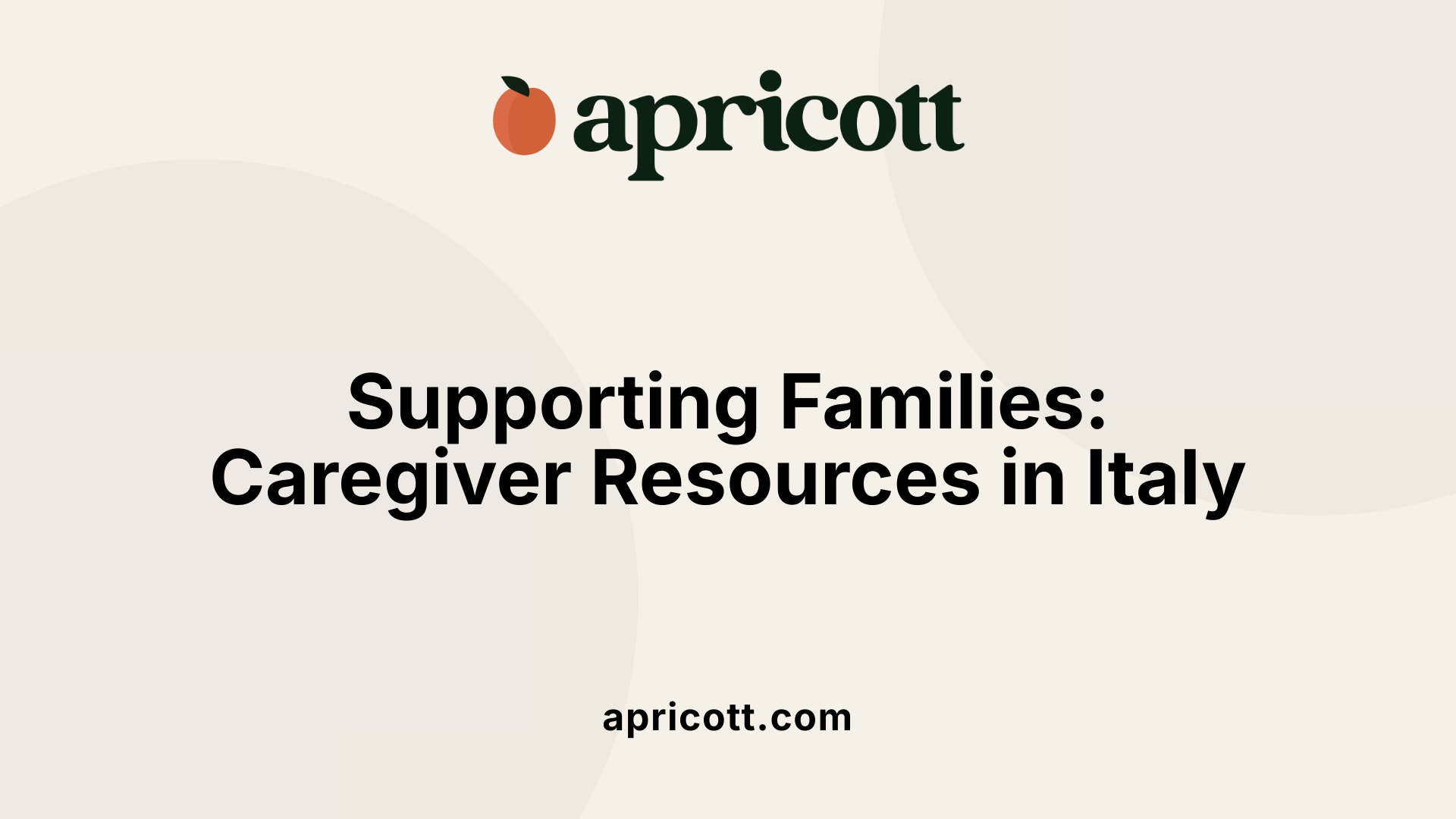
How does the stress and mental health burden affect families of children with autism in Italy?
Families of children with autism spectrum disorder (ASD) in Italy often experience high levels of stress, anxiety, and depression. The lifelong nature of ASD and the demands of caregiving contribute significantly to this mental health burden, impacting both personal well-being and family dynamics.
Why is family involvement important in the effectiveness of interventions?
Research indicates that family involvement plays a crucial role in the success of therapeutic interventions like ABA. In Italy, factors such as the intensity of intervention and active participation of family members enhance developmental outcomes for children with ASD.
What family support services are available in Italy?
Several regions in Italy offer family support services, though provision is uneven. Some child and adolescent mental health services (CAMHs) incorporate training and assistance for families as part of their integrated approach to autism care. However, disparities exist, with northern regions generally providing more comprehensive support compared to the south.
These insights emphasize the need for increased resources and coordinated efforts to support caregivers across Italy, recognizing their vital contribution to therapy outcomes for children with autism.
The Role of Multidisciplinary Approaches in Autism Therapy in Italy
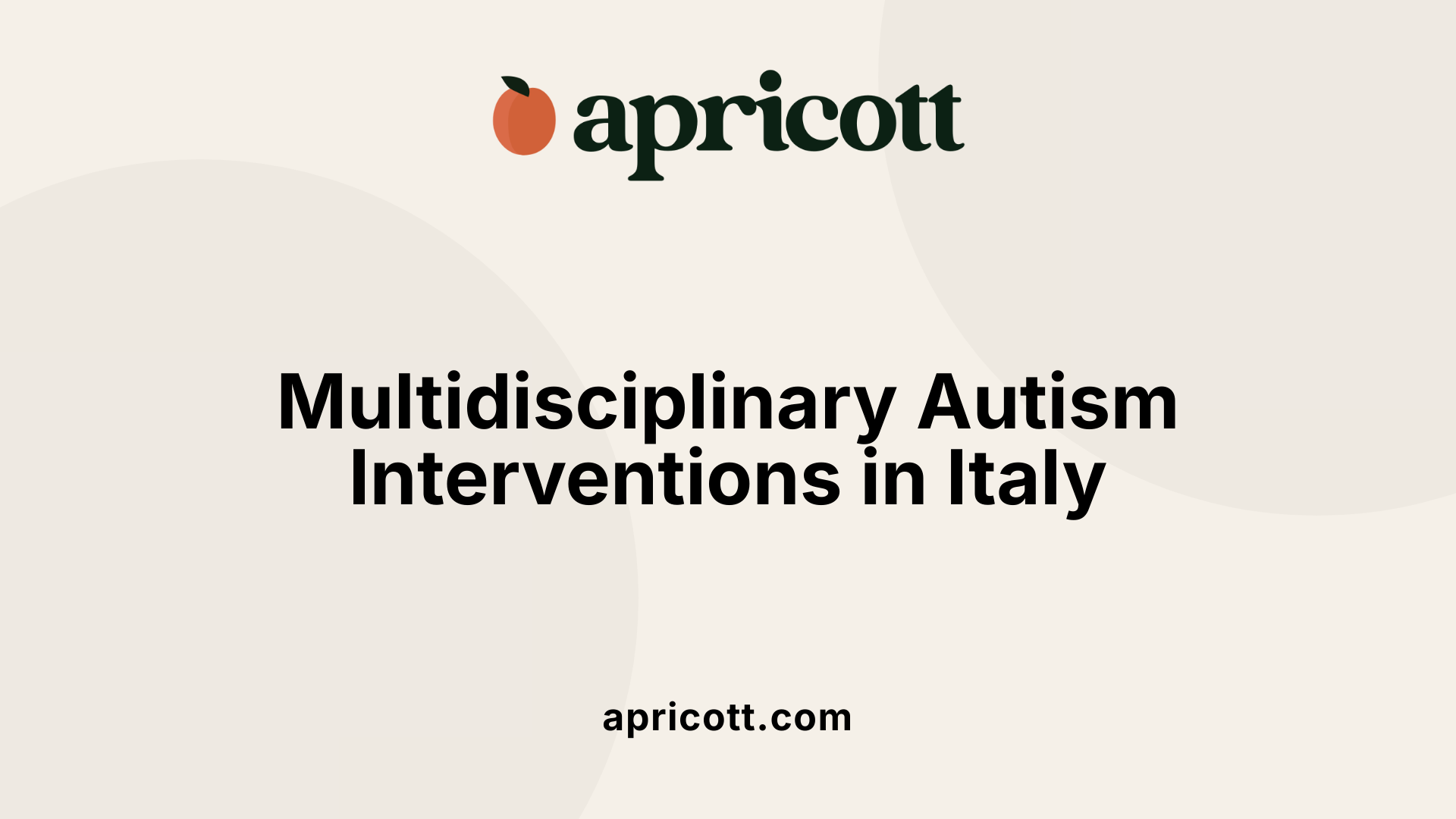
How do multidisciplinary teams collaborate in autism therapy in Italy?
In Italy, autism therapy is delivered through a collaborative effort among psychologists, educators, therapists, and medical professionals. Centers such as Centro Tice exemplify this approach by assembling teams of trained experts, including managers and educators qualified in Applied Behavior Analysis (ABA). This teamwork integrates diverse expertise to create comprehensive treatment plans that are tailored to each individual's needs.
What holistic interventions are used to address diverse needs?
Italian autism interventions often combine behavioral therapies like ABA with communication systems such as the Picture Exchange Communication System (PECS). These therapies improve speech development, reduce maladaptive behaviors, and promote social engagement. Additionally, interventions include speech therapy and strong family support programs ensuring that treatment is comprehensive and considers developmental, educational, cognitive, and linguistic dimensions.
This integrated method leverages the strengths of various disciplines to provide global support involving the student, family, and school environments. Such holistic, multidisciplinary interventions not only address the core features of autism but also enhance generalization across different settings, contributing to better developmental outcomes for children with ASD in Italy.
Community and Educational Inclusion Strategies for Children with ASD in Italy

Collaboration between CAMHs and schools
In Italy, child and adolescent mental health services (CAMHs) play a pivotal role in supporting children with autism spectrum disorder (ASD). These services are integrated into the national health system and often collaborate with schools to foster inclusion. However, formalized diagnostic protocols and agreements between CAMHs and educational institutions are inconsistently established across regions, creating disparities in service coordination.
Inclusion programs and support for social engagement
Educational inclusion of children with ASD is supported through various intervention strategies. Behavioral therapies like Applied Behavior Analysis (ABA) and communication tools such as the Picture Exchange Communication System (PECS) are commonly employed within therapeutic and educational settings. These interventions promote speech development and social engagement, facilitating children’s integration into school environments. Family involvement and multidisciplinary teamwork further support the holistic development and social participation of children with ASD.
Challenges in implementation across regions
Despite these initiatives, regional disparities significantly affect service quality and availability. Northern Italy generally offers better resources, including higher levels of autism-specific training for professionals and stronger financial support, while southern regions face lower coverage and infrastructure limitations. This heterogeneity results in unequal access to coordinated inclusion programs, highlighting the need for national standards and improved collaboration to ensure consistent support for children with ASD throughout Italy.
Use of Assistive and Augmentative Communication Tools in Italy

Role of AAC besides PECS
In Italy, augmentative and alternative communication (AAC) methods extend beyond the widely used Picture Exchange Communication System (PECS) to support individuals with autism spectrum disorder (ASD). AAC tools serve as essential aids for enhancing communication, especially for those who experience speech delays or impairments common in ASD.
These tools include speech-generating devices, symbol boards, and gesture-based systems, all aimed at facilitating functional communication. AAC is integrated within various therapeutic settings, complementing other intervention efforts.
Combination with Speech and Behavioral Therapies
AAC is often applied in conjunction with behavioral therapies such as Applied Behavior Analysis (ABA) and speech therapy, creating a holistic approach to autism intervention in Italy. This combination helps support both verbal and non-verbal communication skills, increasing the overall efficacy of treatment.
Behavioral therapies focus on reducing maladaptive behaviors and promoting social interaction, while AAC provides an alternative medium for expression. Speech therapy addresses language development incrementally, sometimes enhanced by AAC use.
In practice, many child and adolescent mental health services (CAMHs) across Italy integrate AAC into their intervention packages alongside ABA and speech therapy, adapting approaches to each child’s needs. This synergy supports broad developmental goals including social engagement, speech advancement, and behavioral improvements.
These combined approaches contribute to the wide-ranging efforts in Italy to optimize ASD care, although regional disparities in resource availability and training continue to present challenges for uniform application.
Research Collaboration and Scientific Contributions from Italian Autism Centers

Partnerships with Universities
Italian autism centers, including notable institutions like Centro Tice, engage in active collaborations with universities to enhance autism treatment methodologies. These partnerships facilitate a vibrant exchange of knowledge, integrating academic research with practical interventions. Such collaborations underpin the development of innovative therapy approaches, ensuring they are firmly rooted in scientific evidence.
Ongoing Research Projects and Publications
Continuing research efforts in Italy focus extensively on optimizing Applied Behavior Analysis (ABA) and augmenting communication strategies such as the Picture Exchange Communication System (PECS). Italian centers participate in studies that assess therapy outcomes, covering improvements in speech development, social interaction, and behavioral adjustments in children with autism spectrum disorder (ASD). Findings from these projects are regularly disseminated through scientific publications, contributing to the global autism research landscape.
Advancement of Behavioral Analysis and Autism Therapies
Italian centers emphasize a multidisciplinary approach, combining expertise from psychologists, educators, and behavioral analysts to enrich intervention strategies. Entities like Centro Tice champion a naturalistic ABA approach delivered in specialized settings, complementing training and dissemination activities that promote evidence-based practices across the country. These efforts not only refine therapeutic efficacy but also support the standardized implementation of behavioral analysis techniques within Italy's diverse healthcare and educational systems.
Importance of Early Diagnosis and Intervention for Autism in Italy
Why is early screening and diagnostic assessment crucial in Italy?
Early screening and diagnostic tools are vital in Italy for detecting autism spectrum disorder (ASD) at a young age. Standardized tools like the Autism Diagnostic Observation Schedule-Generic (ADOS-G) and Childhood Autism Rating Scale (CARS) are commonly used, albeit with regional variation. Early identification through such reliable assessments enables quicker access to tailored interventions, which can significantly influence developmental trajectories.
How do timely ABA and PECS interventions improve outcomes?
Prompt initiation of Applied Behavior Analysis (ABA) and Picture Exchange Communication System (PECS) therapies leads to notable gains for children with ASD in Italy. ABA, endorsed by Italian health authorities, systematically enhances communication, social, and cognitive skills, especially when started early and intensified appropriately. PECS specifically fosters communication abilities and social engagement, showing effectiveness in Italian studies.
What advantages arise from early intervention?
- Enhanced speech and language development
- Reduction of maladaptive behaviors
- Improved social integration and interaction
- Support for families in managing ASD challenges
How does the Italian context support early intervention?
Italy's network of Child and Adolescent Mental Health Services (CAMHs) provides a framework for early diagnosis and intervention, despite regional disparities. Training for professionals and availability of evidence-based therapies, including ABA and PECS, are fundamental components in the therapeutic approach. Intensive family involvement and educational support further bolster intervention success.
The combination of early, accurate diagnosis with immediate, evidence-based interventions like ABA and PECS promotes better developmental outcomes for children with autism in Italy, highlighting the importance of strengthened regional coordination and resource distribution.
Cultural and Social Factors Affecting Autism Therapy Uptake in Italy
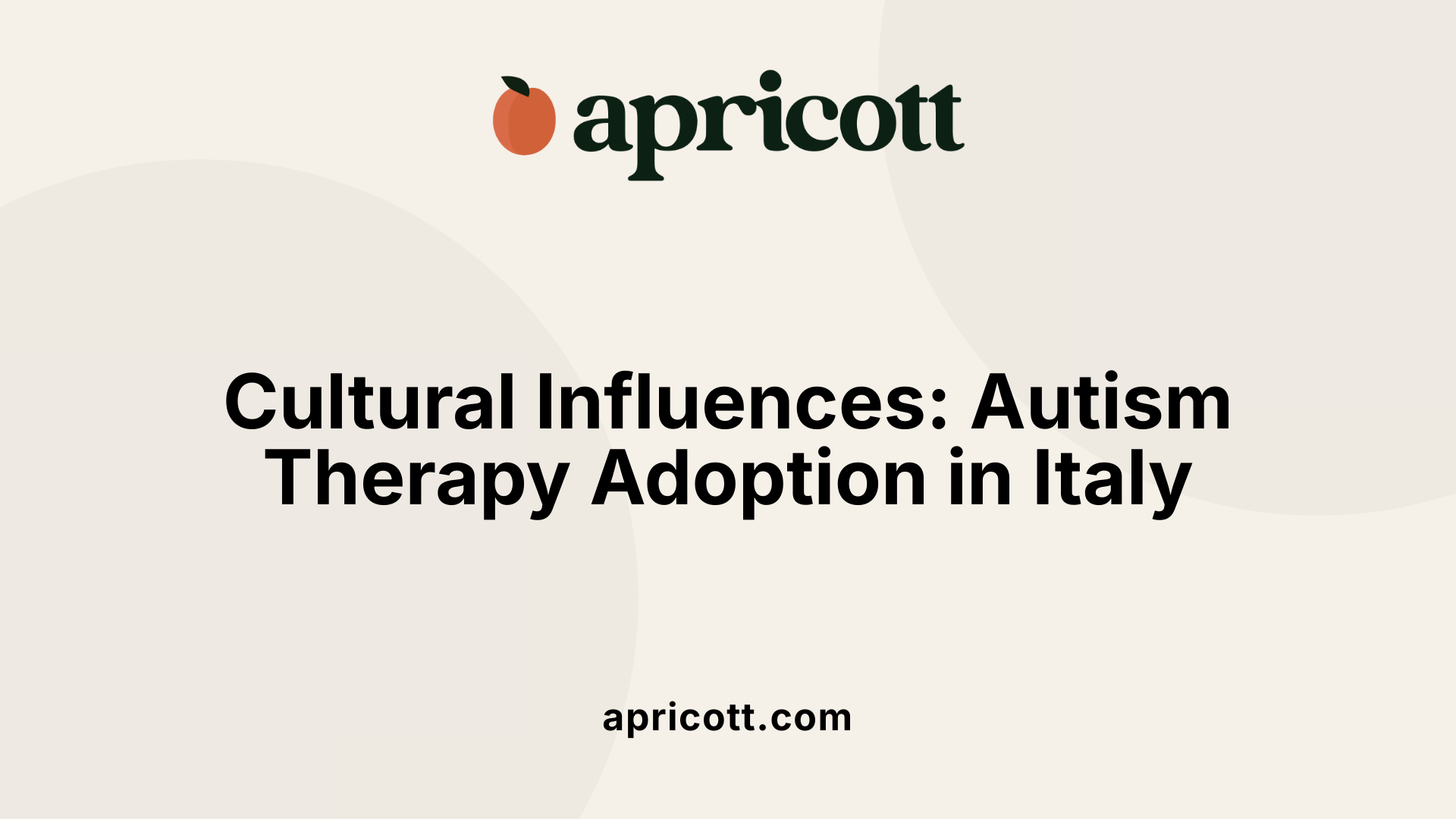
Public Awareness and Stigma
In Italy, public awareness regarding autism spectrum disorder (ASD) has been growing, supported by the national health system's integrated services and regional initiatives. Despite this progress, stigma surrounding ASD persists, particularly in southern regions where resources and specialized services are less accessible. This stigma can affect the willingness of families to seek early intervention and participate in therapies, potentially delaying support that is crucial for developmental progress.
Family Attitudes and Regional Cultural Influences
Family perspectives on autism therapy vary significantly across Italy, influenced by regional cultural values. Northern areas tend to have a more biomedical and intervention-oriented approach, partly due to better availability of trained professionals and comprehensive services. In contrast, southern regions may demonstrate more traditional views towards developmental disorders, which, combined with fewer resources, can impact the acceptance and uptake of therapies like ABA and PECS.
The involvement of families is recognized as a critical factor in the effectiveness of interventions, particularly in evidence-based therapies such as ABA. Training programs aimed at parents emphasize the importance of home support alongside professional care. However, disparities in training opportunities across Italy reflect broader regional inequalities.
Efforts to promote harmonized protocols and improve regional collaboration aim to address these cultural and social barriers. By fostering greater understanding and reducing stigma, Italy seeks to enhance therapy uptake and optimize outcomes for children with autism nationally.
Government and Non-governmental Roles in Autism Services Development
What policies and funding initiatives support autism services in Italy?
Italy has been making gradual strides in establishing policies aimed at supporting individuals with Autism Spectrum Disorder (ASD). Efforts include ongoing work to implement regional ASD policies that promote harmonized diagnostic and intervention protocols. These initiatives focus on integrating public and private service providers to enhance coverage and reduce fragmentation within the system. Funding is predominantly channeled through the National Health Service, with funding disparities observed geographically—Northern regions generally receive more financial resources and offer higher quality services compared to Southern areas. Public child and adolescent mental health services (CAMHs) contribute significantly, delivering a range of interventions including behavioral therapies and communication assistance.
How do private entities and NGOs contribute to autism care in Italy?
Private entities, including private CAMHs, play a crucial role by often spearheading diagnostic services, which complements public sector efforts. Non-governmental organizations (NGOs) and centers like Centro Tice enrich the autism service landscape through specialized interventions founded on Applied Behavior Analysis (ABA). Centro Tice’s multidisciplinary approach involves collaboration among psychologists, educators, and families, emphasizing research, professional training, and dissemination activities that advance evidence-based behavioral therapies in Italy. Private and NGO involvement helps broaden service accessibility, especially in regions where public offerings may lack coverage or expertise.
The government and non-governmental sectors therefore work in tandem, albeit with some regional disparities, to provide a network of support for individuals with ASD, highlighting ongoing needs for unified standards and better coordination across Italy.
Future Directions for Autism Care and Research in Italy
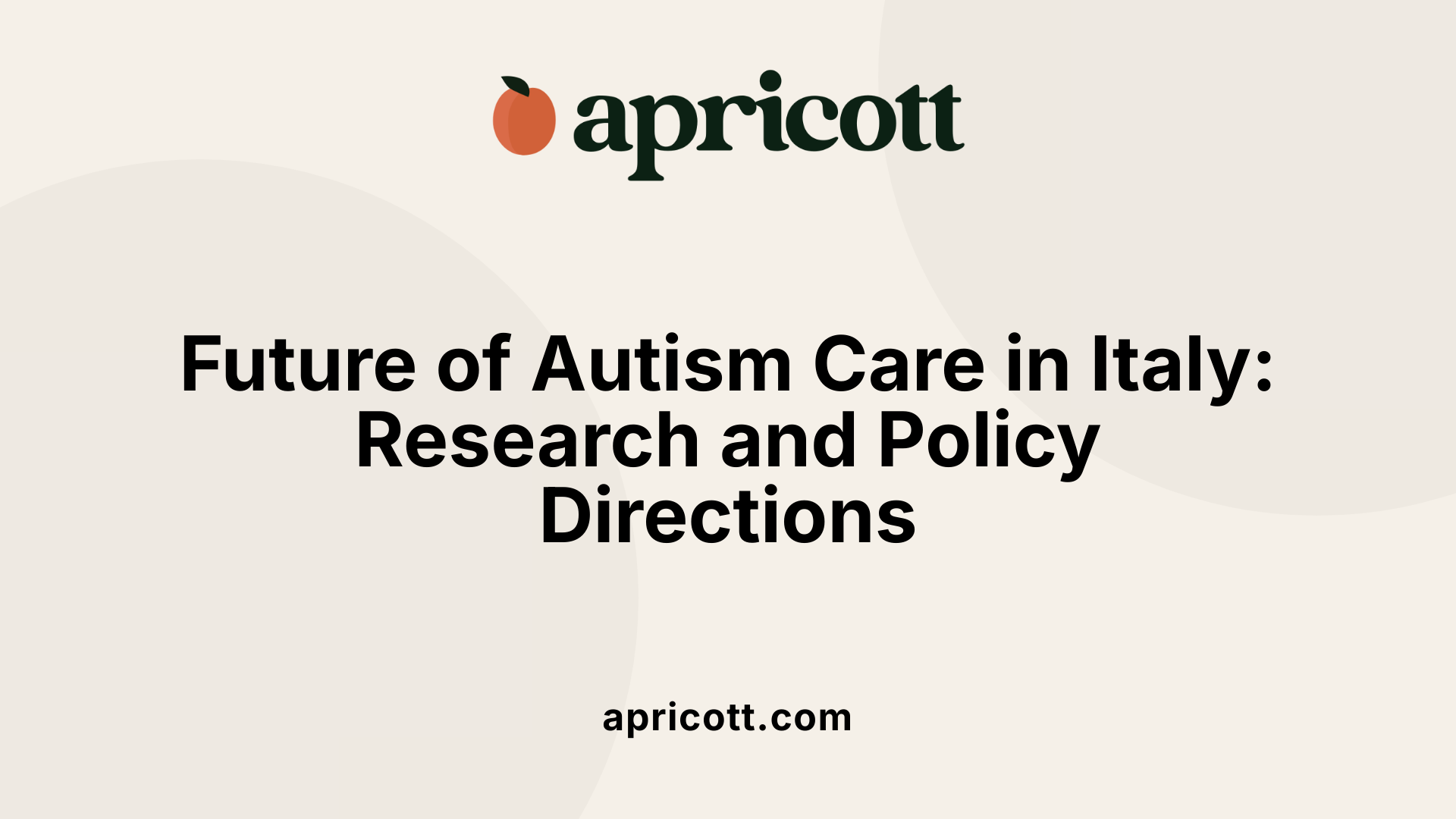
Why is there a need for national harmonization of autism services in Italy?
Despite Italy's well-established network of child and adolescent mental health services (CAMHs) integrated into the national health system, there is significant variability across regions. The North generally boasts better resources, infrastructure, and financial support for autism services compared to the South. Variations exist in the adoption of diagnostic tools, the provision of intervention services, and levels of professional training. These disparities highlight the pressing need for national standards and streamlined protocols. A harmonized approach would ensure equitable access to quality diagnosis, treatment, and support nationwide, reducing fragmentation and improving continuity of care.
How can professional training for autism care be expanded?
Current autism-specific training is unevenly distributed across Italy, with more developed programs in northern regions. To elevate the quality of care uniformly, it is essential to expand training opportunities for professionals throughout the country. This includes increasing funding, offering specialized courses in Applied Behavior Analysis (ABA), Picture Exchange Communication System (PECS), and other evidence-based interventions. Encouraging multidisciplinary collaboration among psychologists, educators, speech therapists, and healthcare providers is also vital. Structured training programs for both professionals and families will empower caregivers and improve intervention outcomes.
What role does family and community integration play in shaping future autism services?
Families and caregivers face considerable stresses linked to autism, underscoring the importance of family-centered approaches. Future efforts should focus on strengthening support systems that incorporate family involvement, school collaboration, and community resources. Institutions like Centro Tice exemplify a global coverage model that embraces the student, family, and school, fostering environments conducive to generalizing learned skills. Enhancing community integration through awareness campaigns and inclusion initiatives can promote social engagement for individuals with autism. Such integration is crucial for sustaining lifelong support and improving quality of life.
By focusing on these future directions, Italy can build on its progress in autism care and research, moving toward more consistent, accessible, and comprehensive services nationwide.
Economic Considerations and Sustainability of Autism Therapies in Italy

What are the cost implications of lifelong ASD care in Italy?
Caring for individuals with autism spectrum disorder (ASD) in Italy involves significant long-term economic challenges. ASD is a lifelong condition that impacts not only the individuals affected but also their families and caregivers, who frequently experience heightened stress, anxiety, and depression. The cumulative personal and societal costs include healthcare, education, and support services over the entire lifespan.
Given the approximately 600,000 people with ASD in Italy — including around 100,000 under the age of 18 — the financial demands on the healthcare system are substantial. These costs encompass diagnostic assessments, ongoing behavioral and communication therapies, educational support, and family caregiving assistance.
How do insurance and educational programs support therapies like ABA?
Italy's national network of child and adolescent mental health services (CAMHs) integrates many therapeutic interventions such as Applied Behavior Analysis (ABA), speech therapy, and augmentative communication methods. Public CAMHs cover approximately 75% of ASD intervention services, with regional variations notably between northern and southern areas.
Insurance and public funding contribute toward these evidence-based therapies, but disparities in service quality and availability persist. Training programs for professionals and parents help support the sustainable delivery of therapies like ABA and the Picture Exchange Communication System (PECS).
Furthermore, educational programs collaborate with health services to enhance social integration and therapy generalization across settings. Despite these supports, regional inequalities suggest ongoing challenges in ensuring uniform access and financial coverage for ASD treatments throughout Italy.
Technology and Innovation in Autism Therapies within Italy
Emerging digital tools supporting behavioral and communication interventions
While traditional methods like PECS (Picture Exchange Communication System) and ABA (Applied Behavior Analysis) form the backbone of autism therapy in Italy, there is a growing interest in integrating digital tools to enhance these interventions. Emerging technologies include mobile apps that facilitate communication through picture exchange, virtual reality modules that support social skills training, and software platforms enabling remote ABA supervision and data tracking.
These tools aim to complement existing therapies by providing interactive, engaging, and easily accessible means to reinforce behavioral and communicative skills. For example, digital PECS applications can enable children to practice exchanging pictures in various environments, helping generalization beyond clinical settings.
Research on efficacy of new technologies
Though Italy's autism therapy infrastructure relies heavily on established practices, recent studies have begun examining the benefits of digital innovations. Early research indicates that integrating technology into ABA programs can improve consistency in data collection and increase the intensity of interventions by offering more frequent practice opportunities.
Similarly, pilot programs using digital communication aids alongside traditional AAC (Augmentative and Alternative Communication) methods report enhancements in motivation and engagement among children with ASD. Ongoing collaborations between Italian universities, research centers like Centro Tice, and clinical services are evaluating the long-term impacts of these digital technologies on speech development, social interaction, and behavior reduction.
Together, Italy's gradual adoption of innovative technology within autism therapies represents a promising advancement, potentially addressing disparities in service quality and accessibility across different regions. Continued research and structured implementation will be crucial to fully harness these tools' potential in supporting children with ASD and their families.
Toward an Integrated and Equitable Future for Autism Support in Italy
Despite Italy's well-established healthcare framework and the availability of evidence-based therapies such as ABA and PECS, significant challenges remain, particularly the regional disparities in service quality and accessibility. Continued efforts to harmonize policies, expand professional training, and foster collaboration among families, educators, and therapists are vital. Advancing research and disseminating best practices will further enhance therapy outcomes. Ultimately, by bridging gaps and building on existing foundations, Italy can ensure that individuals with autism across the country receive the support and opportunities necessary to lead fulfilling and independent lives.
.svg)
.svg)








